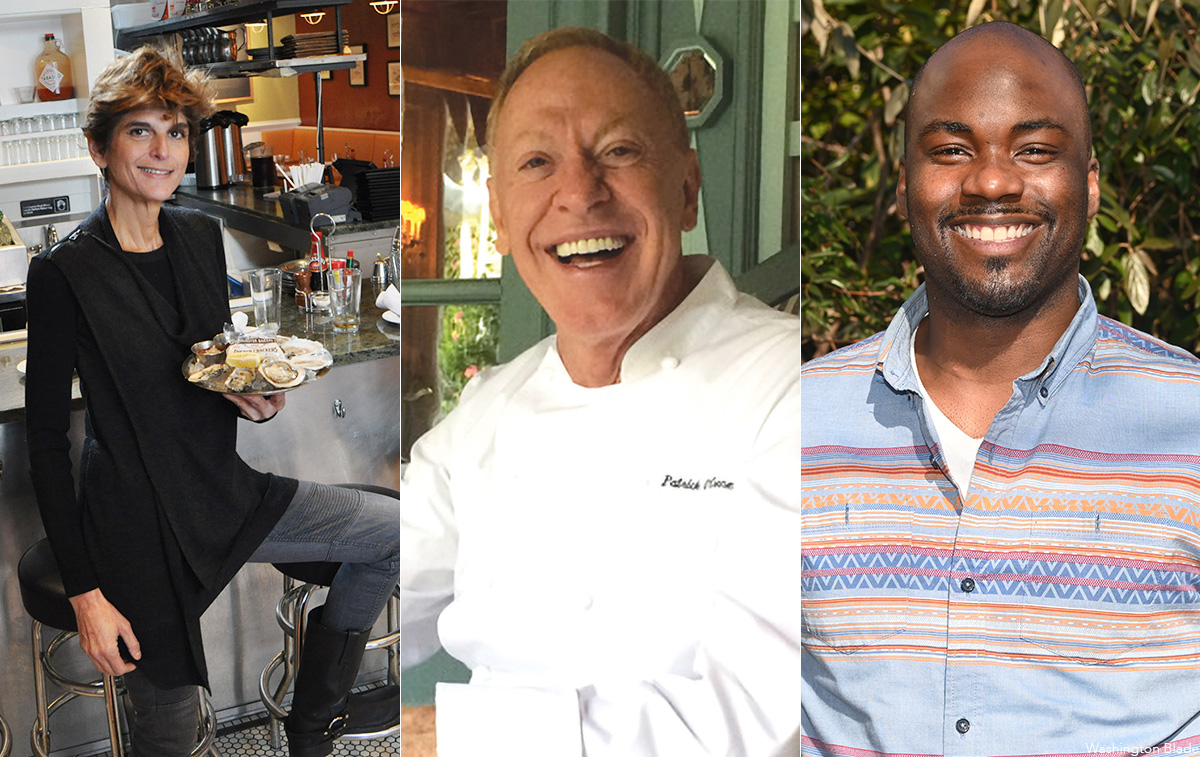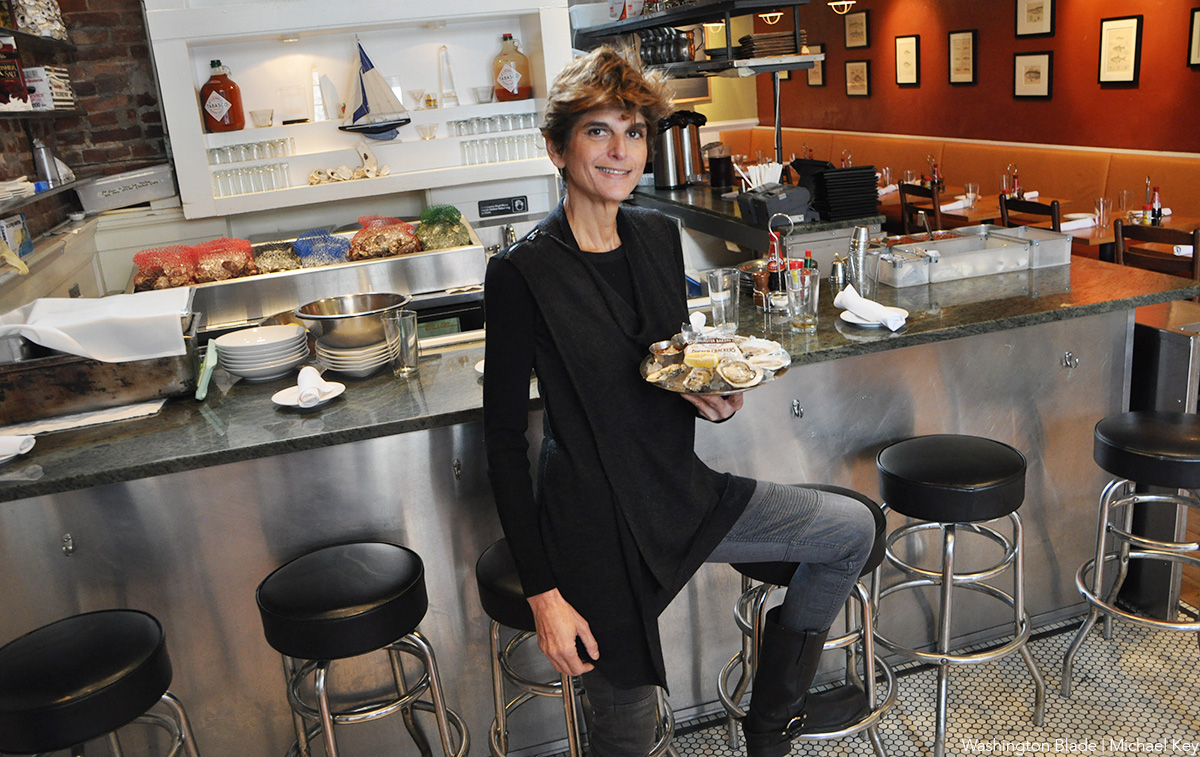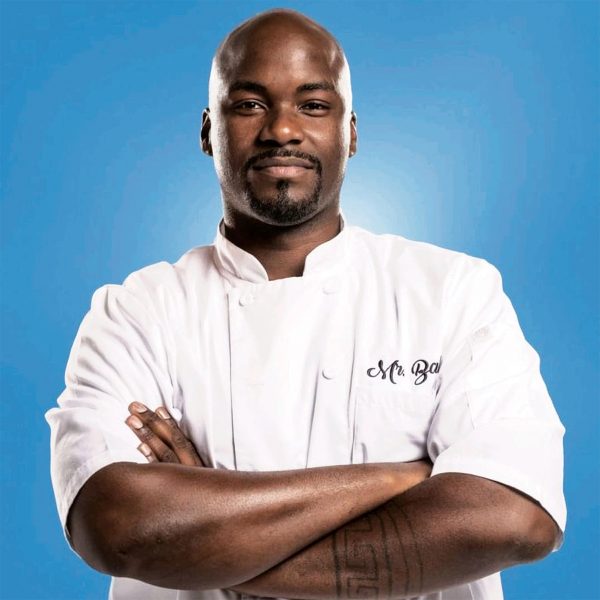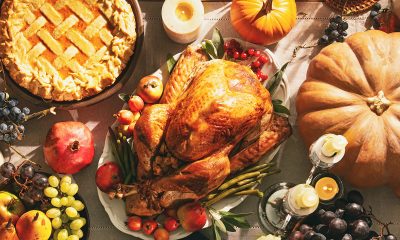a&e features
Local LGBTQ chefs share favorite Thanksgiving recipes
Happy holidays from Jamie Leeds, Patrick O’Connell, Mr. Bake and more

Delightful dishes and cool cocktails are at least one guaranteed way to bring joy to Thanksgiving when the season may look challenging. This year, we asked prominent local LGBTQ chefs, mixologists, sommeliers, and restaurateurs to offer recipes and suggestions for Thanksgiving.
Jamie Leeds, Hank’s Oyster Bar

This recipe is the ultimate ode to Chesapeake Bay oysters, using both the oyster and its juice (known as the liquor) to season the stuffing. Leeds is a pioneer in the restaurant industry in Washington, D.C., and was also a a former Washington Blade Most Eligible Single.
Chesapeake Oyster Stuffing
(8 servings)
1 pint (approx. 24) Shucked Chesapeake oysters with liquor
1 cup Celery, small dice
1 cup Yellow onion, small dice
1 stick Butter
1 tsp Salt
1/2 tsp Old Bay seasoning
1/8 tsp Tarragon, fresh
1/8 tsp Thyme, fresh
1/2 tsp Lemon juice
4 Cups Bread, day old, 1”cubes
3 Tbsp Parsley, fresh, chopped
2 Each Eggs, beaten with 2 T water
Steps:
Strain oysters, reserving their liquid. Place oysters in a large mixing bowl with the cubed bread. Preheat oven to 400 degrees. Coat the inside of a 2-quart (or slightly larger) baking dish with cooking spray.
In a 10-inch sauté pan, melt the butter and add celery and onions. Cook on medium heat until vegetables are tender, about five minutes. Add salt, thyme, tarragon and Old Bay seasoning, stir to incorporate. Add reserved oyster liquor and cook for 2-3 minutes. Remove from heat and cool to room temperature. Once cool pour over oysters and bread. Mix gently until moistened.
Gently fold in the eggs, lemon juice and parsley until fully incorporated. Transfer to the baking dish, cover and bake for about 30 minutes, then remove the foil and bake for another 10 to 15 minutes, until top is browned. Can be prepared 1-2 days in advance and kept refrigerated before baking. Tip: If you do not have day-old bread, place cubed bread on a baking sheet and put in a 350 degree oven for about 10-15 minutes until the bread is crusty on the outside. Let cool completely before adding oysters.
Mr. Bake’s Award-Winning Banana Pudding

Kareem “Mr. Bake” Queeman is famous for not only his fabulous presence on social media and reality TV, but also his Banana Pudding, which is the perfect addition to your holiday table. In this recipe, the James Beard semifinalist baker and owner of Mr. Bake Sweets shares his award-winning banana pudding recipe that helped Kareem win his first-ever competition as a baker (the first of many!), and showcase it on the “Kelly Clarkson Show” this past Easter. This is Kareem’s variation on a Southern family recipe passed down by his late aunt Janet Wills.
This holiday dessert is a delicious combination of easy to find and affordable grocery store ingredients, and even includes an option to use store-bought pudding mix if you’re in a time crunch (just make sure to save time to put your pudding in the fridge). Just keep in mind that you’ll need to chilled a bowl in advance and a standard mixer to make sure you get that perfect fluffy texture in the pudding. If you’re feeling extra ambitious, you can make a homemade whipped topping or spring for store-bought in a pinch to add as a final topping on your pudding. Serve in bowls or eat it straight out of the bowl (we won’t judge) this pudding is sure to impress all season long.
Technique Tip:
● Make sure you chill your bowl and mixer attachments before whipping your
heavy cream into cream. This helps ensure the heavy cream whips up nice
and high, and won’t take as much time.
● Make sure the bowl isn’t touching the water when placing your custard bowl
over the double boiler. You’re using just the steam to cook, dissolve and
double your custard in volume.
● Temper your eggs into the cream make sure you add about a cup of the hot
into the egg mixture. This helps make sure you don’t cook and scramble eggs.
Swap Option:
● You can use all heavy cream or whole milk for Half and Half. (Half and Half is
equal parts heavy cream and whole milk)
● You can use Cool Whip if you don’t have heavy cream to make whipped cream
(use about 3 to 4 cups of Cool Whip)
Serving Size: Serves 12 to 15 people
Yield: Makes about 5 to 6 cups of custard.
Prep Time: Custard 6-8 minutes for cook and prep, 2 hour- overnight for chilling
3-6 minutes to whip and blend in custard into the sweeten whipped cream
6-10 minutes to assemble
30 min chill time in the fridge once everything is layered
Cook Time: 6-8 minutes
Serve and keep chilled and enjoy.
Hand mixer/stand mixer
Banana Pudding Trifle (From Scratch)
● 8 large egg yolks
● ½ cup granulated sugar
● 6 tablespoons cornstarch
● ½ teaspoon kosher salt
● 3 cups half & half
● 2 tablespoons pure vanilla extract
● 3 tablespoons unsalted butter, room temperature
● 14 oz can condensed milk
● 2 cups heavy cream
● 3 tablespoon confectioners sugar
● Vanilla wafer cookies 3 to 5 standard boxes (Nabisco preferred)
● 4-5 large bananas, sliced
● Optional: Whipped cream for topping
Preparation:
1. In a large heatproof bowl, whisk together egg yolks, sugar, cornstarch and
salt until well blended. The mixture will be thick and pale in color. Set aside.
2. In a medium saucepan, heat the half & half to a rolling boil (do not actually
boil). Remove pot from the heat.
3. Whisk 1 cup of the half and half into the egg-yolk mixture. Mix until
combined, then whisk in the rest of the half and half.
4. Set the bowl over a pot of simmering water (make sure the bottom of the
bowl doesn’t touch the water in the pot). Cook and whisk constantly, until the
mixture has thickened, 5 to 7 minutes.
5. Remove the bowl from the heat and whisk in vanilla until combined. Let the
mixture sit and cool, 2 to 3 minutes.
6. Whisk in the butter until it is melted and the pudding is smooth and silky.
7. Place a piece of plastic wrap directly on top of the pudding and let cool to
room temperature, about 30 minutes to an hour.
8. Whisk in the condensed milk and chill for 2 hours or overnight.
9. In the bowl of a standard mixer, use the whisk attachment to whip the heavy
cream on medium speed until it starts to thicken. Add the sugar and beat
until the cream holds stiff peaks. (Whipped cream should stand straight up
and stand in place when you remove your attachments.
10. Add the chilled pudding custard to the sweetened whipped cream, gently
folding it into each other.
11. To assemble the trifle, spoon 1/3 of the pudding into a glass trifle bowl. Top
with sliced bananas then wafer cookies. Repeat this process ending with
custard at the top, then add fresh sliced bananas, crushed wafer cookies and
fresh whipped cream (optional) as décor.
Executive Chef Harley Peet, Bas Rouge
As a longtime resident of the Eastern Shore and an avid waterman, seafood naturally takes center stage in Peet’s dishes. Holidays conjure warmth, and the very essence of comfort food is the pot pie. On the Eastern Shore, where salty air mingles with generations of watermen’s tales, the choice was clear. Sweet, tender lobster and delicate sea scallops elevate this timeless classic, where rustic tradition meets refined flavor and presentation in a dish that captures a sense of place.
Scallop and Lobster Pot Pie on a Scallop Shell
Yield: 4 servings
• 1 sheet puff pastry, cut into quarter-size circles
• 1 each egg
• 1 tablespoon milk
• 5 slices smokey bacon, cut into half-inch pieces
• 2 tablespoons unsalted butter
• 1/2 cup celery, small diced
• 1/2 cup onion, small diced
• 1/2 cup carrots, small diced
• 3 tablespoons all-purpose flour
• 1 quart heavy whipping cream, cold
• To taste pepper, freshly ground
• To taste lemon, juiced
• 2 ounces Parmesan cheese, grated
• 1 each lemon, sliced into wedges
• Salt to taste
• 4 each large sea scallops, raw and sliced into quarters [ask for scallop shells]
• 2 each [2.5 lbs.] steamed lobster, diced into half inch pieces
• Parmesan cheese, grated, to taste
Preheat the oven to 400 degrees. In a small mixing bowl, beat the egg and add the milk to create an egg wash. Place the quarter-size circles of puff pastry on a baking sheet and brush the puff pastry with the egg wash. Bake in the oven for 12-15 minutes, or until the pastry is puffed and golden brown. Set the puff pastry aside.
Brown the bacon in a heavy-bottom Dutch oven or saucepan, such as Le Creuset or Staub. Once the bacon is browned, remove it from the Dutch oven and set it aside. Do not discard the bacon fat. Add the butter to the bacon fat in the Dutch oven. Add the celery, onion, and carrot to the pot, and sweat out the vegetables until they are translucent and soft. Take the Dutch oven with the vegetables off of the heat and sprinkle the flour over the vegetables to make a roux. Return the Dutch oven with the roux to the stove over medium heat. Add the cold heavy whipping cream and whisk to remove roux balls. Season the mixture with freshly ground pepper, to taste, and a squeeze of lemon juice, to taste, for a bit of acidity. Simmer the mixture until it gets thick. Once the mixture has thickened, remove it from the heat. Fold in the scallops and lobster into the mixture. Grate the Parmesan cheese into the mixture and stir to incorporate all ingredients. Set the mixture aside, and let it cool in the refrigerator. To note – the mixture can be made up to a couple of days in advance and kept in the refrigerator. (Add the seafood after to extend the lifetime of the mixture or use it immediately.)
Preheat the oven to 350 degrees Fahrenheit. Arrange the scallop shell on a flat baking tray. If needed, arrange with some salt or oven-safe ware to hold the shells upright, in order to keep them from tipping over and losing the topping mixture [they will not fall or warp]. Scoop a [generous] tablespoon of the cold mixture into a scallop shell and top it with a sprinkling of Parmesan cheese. Bake in the oven until the cheese is bubbling and golden brown, or approximately 6-8 minutes. Top each stuffed scallop shell with a pre-baked puff pastry round. Garnish with lemon wedges and serve.
Chef Patrick O’Connell, Inn at Little Washington

Chef Patrick O’Connell, renowned for his three Michelin stars at The Inn at Little Washington, is excited to share one of his beloved recipes for the holiday season.
For nearly four decades, a shot of this soup was served as the first course on The Inn at Little Washington’s tasting menu during the winter months. This beloved classic from Chef Patrick O’Connell found a new life at Patty O’s Café and has been touted as “The world’s most refined version of bean soup.” Pureeing the beans and adding a touch of cream makes for a delicate soup, but all the hearty flavors remain intact. The best of both worlds, and a perfect beginning for a fall or cold weather dinner.
White Bean Soup with Virginia Country Ham
Ingredients (serves 8)
• 1/2 pound dried Cannellini or Great Northern Beans
• 5 strips of bacon
• 2 medium onions, coarsely chopped
• 5 leeks, chopped and thoroughly cleaned
• 1 cup chopped celery
• 4 bay leaves
• 4 quarts chicken stock, preferably homemade
• 1 ham bone (optional)
• 2 cups heavy cream
• Salt and cayenne pepper to taste
• Optional garnishes: shaved country ham; fresh cream, whipped; cracked black pepper; minced chives
Directions:
1. In a medium saucepan, cover the beans with cool water and soak overnight.
2. In an 8 quart stock pot, cook the bacon over medium high heat until browned. Add the onion, leeks, celery, and bay leaves and cook until the vegetables are tender, about 15 minutes.
3. Drain and rinse the beans and add them to the stock pot along with the heated stock and ham bone (if using). Simmer until the beans are very soft, about 1 hour.
4. Remove the ham bone and bay leaves from the soup. Puree the soup in small batches in a blender or food processor and strain.
5. Return the soup to the heat and add the cream. If the soup is too thick, add more stock or cream. Season with salt and cayenne.
6. At Patty O’s Café, we pour the soup tableside over a bed of shaved local Virginia ham, and garnish with fresh cream whipped with cracked black pepper and fresh chives.
Jonathan Dearden, KNEAD Corporate Chef
KNEAD, one of the largest D.C.-based restaurant groups, is owned by gay couple Jason Berry and Michael Reginbogin.
Chef Dearden’s favorite recipe from the Succotash Prime menu that is perfect for Thanksgiving: “Gochujang Brussels Sprouts on our Succotash Prime menu is one of my favorite unique Thanksgiving sides. At the restaurant we fry in the deep fryer. This recipe has been adjusted to use an Air Fryer.”
Air Fried Gochujang Brussels Sprouts
Gochujang Vinaigrette
• 380g gochujang (hot)
• 150g orange juice
• 20g garlic, minced
• 30g ginger, minced
• 20g Fresno chilies, finely chopped
• 100g lime juice
• 100g rice wine vinegar
• 10g salt
• 750g canola or vegetable oil (approx. 1 quart)
In a blender or food processor, combine gochujang, orange juice, garlic, ginger, Fresno chilies, lime juice, rice wine vinegar, and salt. Blend until smooth.
With the blender running, slowly stream in the canola or vegetable oil to emulsify. Adjust seasoning if needed.
For Plate-Up
• 500g Brussels sprouts (about 1 pint)
• 50g gochujang vinaigrette
• 15g garlic chili crunch
• 3g sesame seeds (white and black, mixed)
• 3g scallions, sliced
• Salt and black pepper, to taste
Preheat air fryer to 400°F (200°C).
Toss the Brussels sprouts with a small amount of oil (just enough to lightly coat them) and season with a pinch of salt.
Place the Brussels sprouts in the air fryer basket in a single layer. Cook for 12-15 minutes, shaking the basket halfway through, until the sprouts are golden brown and crispy.
Transfer the air-fried Brussels sprouts to a large bowl. Drizzle with 50g of the gochujang vinaigrette, tossing lightly to coat but keeping them crispy. Season with salt and black pepper as needed.
Plate the Brussels sprouts in a serving bowl and garnish with garlic chili crunch, sesame seeds, and sliced scallions.
Anthony Aligo, Barkada Wine Bar
Aligo Aligo and business partners Nicholas Guglietta and Nathan Fisher, all gay men, founded their cozy wine bar in late 2020. They are offering two recipes this season: mushroom stuffing and a cranberry royale drink.
Mushroom Stuffing
This savory and earthy dish is perfect for Thanksgiving, featuring tender mushrooms, aromatic herbs, and hearty bread. It’s an excellent alternative or complement to traditional stuffing, especially for vegetarians or mushroom lovers. The dish balances rich flavors and comforting textures, making it a great side that pairs well with other Thanksgiving favorites like turkey, gravy, and cranberry sauce. With its umami depth and seasonal ingredients, this stuffing brings warmth and variety to the holiday table.
Mushroom Stuffing
Ingredients
• 12 cups of one-inch dried bread cubes or dried stuffing mix
• 1/2 cup salted butter
• 2 onions
•1 cup celery
•1 clove garlic
•1/2 lb of your favorite mushrooms
• 2 cups chicken or turkey broth
•1/3 cup fresh parsley
• 2 tsp fresh rosemary
Melt butter in a large saucepan over medium heat. Add sliced mushrooms, onions, celery and minced garlic. Cook until tender. Pour in chicken/turkey stock. Add minced parsley and rosemary and salt and pepper to your liking. Let simmer for 1-2 minutes.
Add bread cubes to a large bowl. Pour the mixture in a bowl and mix. Stuffing should be moist but not mushy. If not moist enough, add water.
Grease a 2-quart baking dish. Add stuffing. Bake for 40-50 minutes at 375 until stuffing is slightly browned on top.
Cranberry Royale
This drink is a festive and refreshing cocktail, perfect for Thanksgiving celebrations. With a blend of tart cranberry juice, a hint of orange, and a splash of dry Lambrusco, it offers a beautiful balance of flavors and a light, sparkling finish. The cranberry brings a seasonal twist, while the Lambrusco adds effervescence, making it an ideal aperitif to start the holiday. Its bright red hue adds a festive touch to the Thanksgiving table, celebrating the flavors and colors of the season.
• 0.5 oz Vodka
• 0.5 oz Orange Juice
• 1.5 oz Cranberry Juice
• 3.0 oz Lambrusco (dry)
Shake the cranberry, orange, and vodka with ice, and strain into a flute or coupe. Top with Lambrusco and garnish with orange peel.

Some gifts scream practical, others whisper luxury, and a few flat-out blur the lines. From cocoa that feels ceremonial to a cologne that linger like a suggestive smirk, this year’s ultimate gift picks prove that thoughtful (and occasionally naughty) presents don’t have to be prosaic. Welcome to your holiday cheat sheet for festive tangibles that get noticed, remembered, and maybe even result in a peck of gratitude planted under the mistletoe. Consensually, of course.
Amber Glass Champagne Flutes
Pop the champs – but make it vintage. These tulip-shaped stunners in amber-tinted glass bring all the Gatsby vibes without the Jazz-age drama. Whether you’re toasting a milestone or celebrating a Tuesday, their seven-ounce capacities and hand-wash-only care make ‘em as practical as they are pretty. Pair with a thoughtful bottle of bubs and gift with a glittering wink. $18, NantucketLooms.com
Disaster Playbook by Here Comes the Apocalypse
Because the end of the world shouldn’t be a solo act, this spiral-bound guide is your step-by-step roadmap to surviving and thriving when everything else goes sideways, which might be sooner than you think. Packed with checklists, drills, and a healthy dose of humor, it’s like a survival manual written by your most prepared (and slightly snarky) friend. Whether you’re prepping for a zombie apocalypse or, more realistically, REVOLUTION!, this playbook’s got your back. $40, HereComesTheApocalypse.com

Wickless Vulva Candles
Bold, luxurious, and completely flame-free, CTOAN’s wickless candles melt from beneath on a warmer, releasing subtle, sophisticated fragrances, like sandalwood or lavender. The vulva-shaped wax adds a playful, provocative element to any space –perfect for a bedroom, living room, or anywhere you want elegance with an edge. A gift that celebrates form, intimacy and self-expression, no fire required. $39, CTOANCO.com
Villeroy & Boch Royal Classic Christmas Collection
Every meal is a mini celebration – with whimsy at every place setting – in Villeroy & Boch’s Royal Classic festive dinnerware collection that hits all the right notes. Made from premium German porcelain, it features nostalgic little toys, nutcrackers, and rocking horses in delicate relief, giving your holiday spread a playful but refined twist. Dishwasher- and microwave-safe, it’s luxe without the fuss. Gift a piece to a special someone, or start a collection they’ll use (and show off) for years to come. $22-$363, Villeroy-Boch.com
Greenworks Electric Lawnmower
You a ’hood queen who considers lawn care performance art – or just wants to rule the cul-de-sac in quiet, emission-free glory? Greenworks’ zero-turn electric mower has the muscle of a 24-horsepower gas engine but none of the fumes, drama or maintenance. Six 60V batteries and a 42-inch deck mean you can mow up to two-and-a-half acres on a single charge – then plug in, recharge, and ride again. It’s whisper-quiet, slope-ready, and smooth enough to make you wonder why you ever pushed anything besides your queer agenda. The perfect gift for the homeowner who loves sustainability, symmetry, and showing off their freshly striped yard like that fresh fade you get on Fridays. $5,000, GreenworksTools.com
Molekule Air Purifier
For the friend who treats their space like a sanctuary (or just can’t stand sneezes), the Molekule Air Pro is magic in motion. Covering up to 1,000 square feet, it doesn’t just capture allergens, VOCs, and smoke – it destroys them, leaving your air feeling luxury-clean. FDA-cleared as a Class II medical device, it’s serious science disguised as modern design. Gift it to your city-dwelling, pet-loving, candle-burning friend who likes their living room as pristine as their Instagram feed. $1,015, Molekule.com

Cipriani Prosecco Gift Set
Effervescent with stone-fruit sweetness and a touch of Italian flair, the Cipriani Bellini & Prosecco gift set brings brunch-level glamour to any day of the week. The Bellini blends rich white-peach purée with sparkling wine, while the dry ’secco keeps things crisp and celebratory. Pop a bottle, pour a flute, and suddenly winter weeknights feel like a party – even with your pants off. $36, TotalWine.com
Woo(e)d Cologne
British GQ recently crowned Woo(e)d by ALTAIA the “Best Date Night Fragrance,” and honestly, they nailed it. Confident without being cocky – smoky gaïac and Atlas cedarwood grounds the room while supple leather and spicy cardamom do all the flirting – it’s a scent that lingers like good conversation and soft candlelight. Gift it to the one who always turns heads – or keep it for yourself and let them come to (and then on) you. $255, BeautyHabit.com

Lococo Cocoa Kit
Keep the run-of-the-mill mugs in the cabinet this Christmas and pull out Lococo’s handcrafted Oaxacan versions that demand you slow down and sip like it matters. Paired with a wooden scoop, rechargeable frother, and Lococo’s signature spice hot-chocolate blend (vegan, gluten-free, with adaptogenic mushrooms), this holiday kit turns Mexi-cocoa into a mini ritual you’ll look forward to. Perfect for anyone who loves a little indulgence with a side of ¡A huevo! energy.
Manta Sleep Mask
Total blackout, zero pressure on the eyes, and Bluetooth speakers built right into the straps, this ain’t your mama’s sleep mask — but it could be. The Manta SOUND sleep mask features C-shaped eye cups that block every hint of light while ultra-thin speakers deliver your favorite white noise, meditation, or late-night playlist straight to your ears. With 24-hour battery life, breathable fabric, and easy-to-adjust sound, it turns any bed (or airplane seat) into a five-star sleep suite. Perfect for anyone who treats shut-eye like an art form (or just wants to escape their roommate’s late-night bingin’ and/or bangin’). $159, MantaSleep.com

Shacklelock Necklace
Turn the industrial-chic vibe of a shackle into a sleek statement. Mi Tesoro’s platinum-plated stainless-steel necklace sits on an 18-inch wheat chain, featuring a shackle-style latch pendant that’s waterproof, tarnish-free, and totally fuss-les. Beyond style, it nods to a classic gesture in the queer leather community: replacing a traditional Master lock with something elegant to quietly signal belonging to someone special. Wear it solo for a minimalist edge or layer it like you mean it; either way this piece locks in both your look and your intentions. $90, MiTesoroJewelry.com
Parkside Flask Mojave Edition
Wine nights get a desert glow-up with Parkside’s limited-edition 750-milliliter all-in-one flask draped in sun-washed bronze and badland hues like sage, sand, and terracotta – with magnetic stemless tumblers that snap on for effortless shareability. It keeps your vino chilled for 24 hours, pours without drips (no tears for spilled rosé, please), and even lets you laser-engrave your own mantra or inside joke. Perfect for picnics, surprise rooftop clinks, or gifting to your favorite wine (or desert) rat. $149, HighCampFlasks.com

Mikey Rox is an award-winning journalist and LGBT lifestyle expert whose work has published in more than 100 outlets across the world. Connect with him on Instagram @mikeyroxtravels.
a&e features
Meet Mr. Christmas
Hallmark’s Jonathan Bennett on telling gay love stories for mainstream audiences

Jonathan Bennett believes there are two kinds of people in the world — those who love Hallmark movies and liars. And in Season 2 of Finding Mr. Christmas, which the Mean Girls star co-created with Ben Roy, Bennett is searching for Hallmark’s next leading man.
“It’s so fun for people because everyone in their life has someone they know that they think should be in Hallmark movies, right? The UPS driver, the barista at the coffee shop, the dentist,” Bennett says. “So we’re testing their acting abilities, we’re testing who they are, but we’re also looking for that star quality — the thing that makes them shine above everyone else. It’s almost something you can’t explain, but we know it when we see it.”
Season 2’s cast includes a former NFL player for the Green Bay Packers, a few actors, and a realtor. The 10 men compete in weekly festive-themed acting challenges, one of which included having to ride a horse and act out a scene with Alison Sweeney. The contestants were chosen from a crop of 360 potential men, and Bennett gives kudos to the show’s Emmy-nominated casting director, Lindsay Liles (The Bachelor, Bachelor in Paradise).
“She has a tough job because she has to find 10 guys that are going to be good reality television, but also have the talent to act, carry a scene, and lead a Hallmark movie eventually,” he says. To be the right fit for a Hallmark leading man, Bennett singles out five key characteristics: you have to be funny, charming, kind, have a sense of humor, and you have to do it all with a big heart.
Of course, Finding Mr. Christmas wouldn’t be Finding Mr. Christmas without its signature eye candy — something Bennett describes as “part of the job” for the contestants. “I can’t believe Hallmark let me get away with this. I dressed them as sexy reindeer and put them in harnesses attached to a cable 30 feet in the air, and they had to do a sexy reindeer photo shoot challenge,” he says with a laugh. “This season is just bigger and bolder than last. People are responding to not only all the craziness that we put them through, but also comparing and contrasting the guys in their acting scenes when we do them back-to-back.”
Season 1 winner Ezra Moreland’s career has been an early testament to the show’s success at finding rising talent. On seeing the show’s first winner flourish, Bennett says, “Now to watch him out in the world, just booking commercial after commercial and shining as an actor and a model, I think the show gave him the wings to do that. He learned so much about himself, and he took all that into his future auditions and casting. He just works nonstop. I’ve never seen an actor book more commercials and modeling gigs in my life.”
Bennett has been a star of plenty of Hallmark movies himself, including the GLAAD-award-winning The Groomsmen: Second Chances, which makes him a fitting host. Among those movies are 2020’s Christmas House, which featured the first same-sex kiss on the network and had a major impact on Bennett’s career as an openly gay man. “Hallmark’s been so great about supporting me in queer storytelling. But again, I don’t make gay movies for gay audiences. I make gay love stories for a broad audience, and that’s a huge difference, right? We’re not telling stories inside baseball that only the gay community will understand.”
He continues, “The backdrop of a Hallmark Christmas movie is very familiar to these people who watch. And so when you tell a gay love story, and you tell it no differently than a straight love story in that space, they’re able to understand. It’s able to change hearts and minds for people who might not have it in their lives.”
While Hallmark has become a major staple of Bennett’s career, he started off wanting to be a Broadway actor. And before the first season of Finding Mr. Christmas aired, Bennett took a break from TV to make his Broadway debut in Spamalot, replacing Michael Urie as Sir Robin and starring alongside Ethan Slater and Alex Brightman.
“That was my dream since I was five years old – then I booked a movie called Mean Girls, and everything kind of changes in your life. You no longer become a person pursuing Broadway, you become a part of pop culture,” Bennett recalls. “And to be honest, when I hit 40, I was like, ‘I’m probably never going to get to live that dream.’ And that’s okay, because I got to do other dreams and other things that were just as cool but different. So I honestly never thought it would happen.”
Bennett is still determined to make his way back on Broadway with the right role — he calls Spamalot the “best experience” of his life, after all — but he’s got another Hallmark show lined up with Murder Mystery House, which he co-created. The show was recently greenlit for development and intends to bring the Hallmark mystery movie to life. “It’s kind of like our version of The Traitors,” Bennett admits.
Looking back on both seasons, Bennett says that what makes Finding Mr. Christmas stand out in the overcrowded reality TV landscape is that everyone involved makes it with heart: “This isn’t a show where you’re going to watch people throw drinks in each other’s faces and get into big fights. The thing that has amazed me so much about this show, the more we’ve done it, is that every season, 10 guys come in as competitors, but they leave as a family and as brothers. That’s something you don’t get on any other network.”
Finding Mr. Christmas airs every Monday on Hallmark through December 20, with episodes available to stream on Hallmark+.
a&e features
Guillermo Diaz on his role as a queer, Latino actor in Hollywood
Shattering stereotypes and norms with long resume of roles

Actor Guillermo Diaz has been working hard in the entertainment industry for more than three decades. Proud of his heritage and queer identity, he has broken through many glass ceilings to have a prolific career that includes tentpole moments such as roles in the films Party Girl, Half Baked, and Bros, and in major TV shows like Weeds and Scandal, and even in a Britney Spears music video. This season, he made his feature-length directorial debut with the film Dear Luke, Love Me.
In an intimate sit-down with the Blade, Diaz shares that he attributes a lot of his success to his Cuban upbringing.
“Well, it prepared me to learn how to lie really well and be a good actor because it was a lot of acting like you were straight, back in the eighties and nineties (laugh). Another thing I learned from my Cuban immigrant parents is that they work super hard. They both had two jobs; we were latchkey kids, and I just saw them constantly working and wanting to provide for us by any means. So that was super instilled in me. That was the one thing that really stuck out that I admire and respect.”
Besides Diaz’s recurring roles on TV, his resume includes appearances in just about every genre of programming out there. If there is a major show out there, he was probably on it. Law and Order, Girls, The Closer, Chappelle’s Show, ER, Party of Five, and the list goes on. He’s accomplished more in his career thus far than most actors do in a lifetime. There is no doubt he is a hard worker.
“It’s a sign that I just loved to work, and it’s funny looking back at it now because you see all those things, but at the time it was just the next gig, the next job. I was just wanting to keep working and acting and learning and doing all that stuff. Then it sort of accumulates, and you look back and you’re like, damn! That’s a lot of stuff!”
Acting was never on Diaz’s radar until he was asked to fill in for a friend in a Beastie Boys medley for a talent show when he was a sophomore in high school.
“I did it and fell in love with it. I was teased a lot in high school. Then, when I did that performance, all those people who teased me were like, you were so great! So I looked at it initially as a thing of like, oh, this is where I’m accepted and people like me when I’m on stage. It’s kind of sad, too, because that’s what I latched onto. And then of course, I fell in love with the craft and performing and acting, but that initial rush was because all these people who were messing with me and teasing me all of a sudden liked me. And I was like, this is what I have to do.”
Little did Diaz know that he would break the mold when it came to stereotypical casting. When he first hit the industry, diversity and positive representation were not a thing in Hollywood.
“You just kind of accepted at the time. It was the early nineties. 90% of the time, it was playing a thug or a gun dealer, or a crack head – it was all bad guys, negative characters. But it was either that or not act and not be in anything. So you just kind of accept it, and then you have this sort of vision or hope that in the future it’s going to get better.
Diaz’s management was trepidatious about him playing gay roles for fear of being typecast. But Diaz did play a handful of gay roles early on, although he passed on But I’m A Cheerleader, which went on to become a gay cult classic. Diaz decided early on that he was not going to hide his sexuality. Diaz appeared in the film Stonewall. That was the defining point for him in sharing his identity.
“Being cast in that historical sort of dramatization of the 1969 Stonewall riots – I couldn’t believe I was in the midst that I was in the middle of doing this and playing the lead drag queen on the film. I just felt so honored, and I knew it was important, and I knew I needed to do a really good job. I thought, what a special moment this is. And it kicked my ass shooting that movie.
I remember after doing Stonewall, people saying, well, now you’re either going to have to make a choice if you’re going to lie, or if you’re going to just be honest, and you’re going to have to be out from now on if you’re going to be honest. And I was like, I’m not going to freaking lie. When they’d asked me, I would say I was gay. I think because I never tried to hide it, it didn’t become a thing. So people just kind of ignored it. It didn’t mess with me or my career. I don’t know. Or I just got lucky. I don’t freaking know.”
As a queer, Latin actor, Diaz is all too aware of what is happening politically and socially in the world towards minority communities. Does he think actors have a place in politics?
“For sure. I mean, we’re people first, right? Like, I hate when people sort of are like, oh, you’re an actor, shut up. I’m super political and outspoken, and I’m that guy who will say shit. I’m on the right side of history, at least. I’m not being complicit and silent. So, yeah, I think actors for sure have a place in politics. Absolutely.”
While directing was on Diaz’s radar, it wasn’t something that he was actively searching out. But as life would have it, his friend Mallie McCown sent him her script for Dear Luke, Love Me, a film she would play the lead in. Diaz was hooked.
“It was one of those scripts that I had to keep putting down every like 20 pages. I would put it down because I didn’t want it to end. It was so good. Originally, I was just going to come on as a producer of the film, and then the director dropped out, and then Mallie asked me if I was interested in directing. I was scared as shit. I had never directed a feature film. But I was like, it’s now or never.”
The film covers a decade of the friendship between Penny and Luke, covering themes of platonic love, asexuality, co-dependence, and self-identity. With most of the film focusing on just the two leads, Diaz has crafted an intimate and raw film. What is his message with the film?
“That love is complicated, but it’s beautiful and rewarding and worth all the heartache. I believe that. I don’t want to give away too much in the film either, but I think everyone can relate to it because there’s heartache and there’s pain, and there’s beauty and there’s love.”
And in looking at his past work and in looking toward his future career, what kind of legacy does Diaz want to build?
“That I broke some ground, that I knocked down some walls as an artist; I’m hoping that made a difference. It’s funny because when you’re in it, you’re not thinking about all this stuff that could possibly pave the way for other people. You’re just kind of moving along and living your life. But yeah, I would hope that I broke down some walls as a queer Latino.
I hope that people can sort of get something out of me trying to live as authentically as I can, just being my queer self. Hopefully, that helps someone along who is having some troubles being accepted or being comfortable with who they are.”
-

 a&e features4 days ago
a&e features4 days agoMeet Mr. Christmas
-

 Puerto Rico4 days ago
Puerto Rico4 days agoPuerto Rico’s largest LGBTQ organization struggling amid federal funding cuts
-

 Opinions3 days ago
Opinions3 days agoVictory Fund continues to shun me and my place in LGBTQ history
-

 National4 days ago
National4 days agoLawmakers warn of HIV crisis as federal support collapses




















